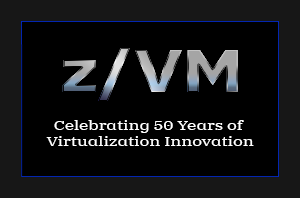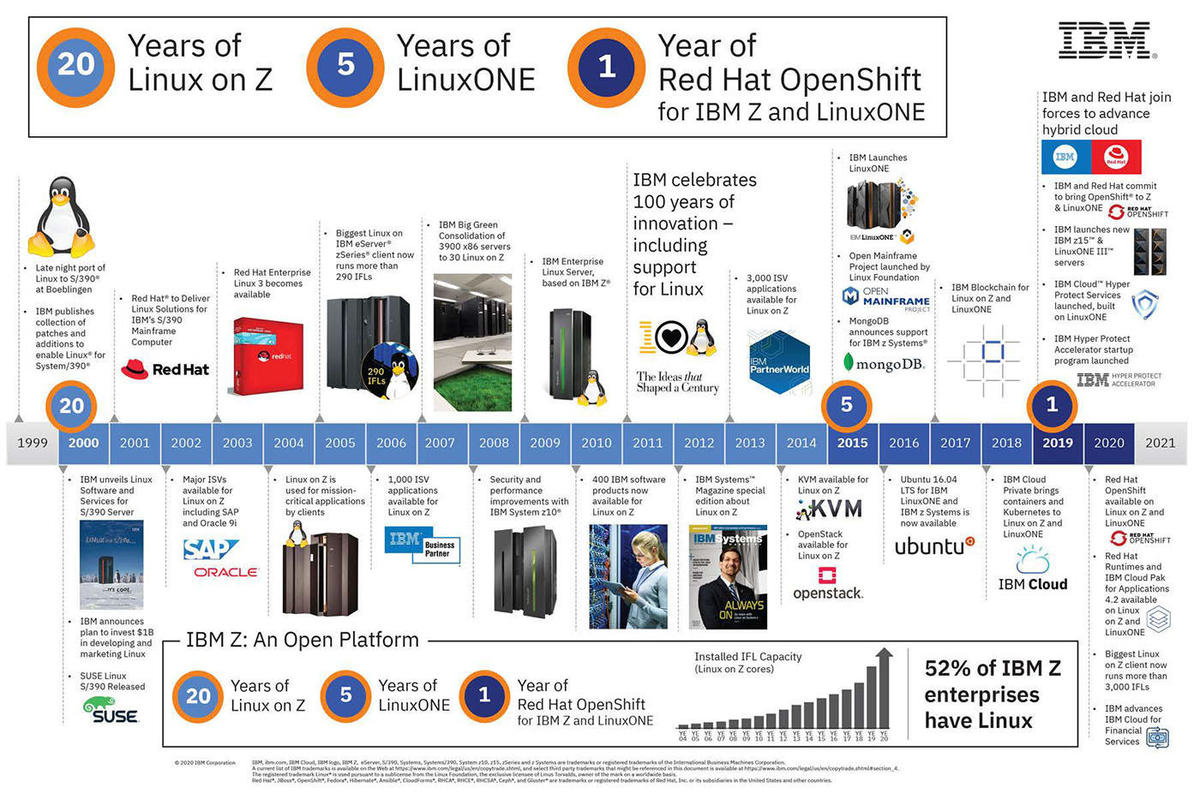Last Updated: 3 August 2022
IBM VM 50th anniversary
A look back through the last 50 years of VM technology and innovation
 On August 2, 1972 VM/370 was announced by IBM along with the first System/370 mainframes that supported virtual memory. This date is
considered VM's anniversary even though the major components of VM (CP and CMS) date back to
the mid 1960s with CP-40 and CP-67. From VM/370 in the 1970s, the operating system spawned
many iterations in the 1980s: VM/SP (System Product), VM/SP HPO (High Performance Option),
VM/IS (Integrated System), VM/XA (eXtended Architecture). In 1990, IBM converged the VM
operating systems to a single product -- VM/ESA.
In the year 2000, IBM announced the introduction of support for the 64-bit z/Architecture,
and as a result, VM's name was changed from VM/ESA to z/VM. z/VM continued the VM/ESA
release numbering convention, and is preparing z/VM 7.3 release later this year. On August 2,
2022 z/VM is celebrating 50 years of virtualization innovation.
On August 2, 1972 VM/370 was announced by IBM along with the first System/370 mainframes that supported virtual memory. This date is
considered VM's anniversary even though the major components of VM (CP and CMS) date back to
the mid 1960s with CP-40 and CP-67. From VM/370 in the 1970s, the operating system spawned
many iterations in the 1980s: VM/SP (System Product), VM/SP HPO (High Performance Option),
VM/IS (Integrated System), VM/XA (eXtended Architecture). In 1990, IBM converged the VM
operating systems to a single product -- VM/ESA.
In the year 2000, IBM announced the introduction of support for the 64-bit z/Architecture,
and as a result, VM's name was changed from VM/ESA to z/VM. z/VM continued the VM/ESA
release numbering convention, and is preparing z/VM 7.3 release later this year. On August 2,
2022 z/VM is celebrating 50 years of virtualization innovation.
The information and videos below capture only a few of the major milestones for the product over the past 50+ years. For a more complete history of VM visit the z/VM history page and the VM timeline for more information.
VM in the 1970s
Users of VM/370 quickly came to understand the advantages of running virtual machines in their environment. IBM shipped the source code with VM/370 to customers which gave them the ability to make custom modifications. VM users would often share their modifications with others which helped create a thriving community.
1972: Introduction to VM/370 video
1975: VM/370 and CMS video demo
VM/370 and S/370s historical documents
- Original "blue page" announcement letter - August 2, 1972
- IBM News - Special Edition: IBM Announces Virtual Storage 370s - August 2, 1972
- IBM Technical Information: IBM S/370 Virtual Storage - August 2, 1972
- Virtual Storage Management - press supplemental information - August 2, 1972
- Special Bibliography of Publications Supporting IBM S/370 Advanced Function - August 2, 1972
- IBM VM/370 Quick Guide for Users - April 1973
- Penetrating an operating system: a study of VM/370 integrity - January 1976
- VM/370-a study of multiplicity and usefulness - IBM Systems Journal - 1979
- The Origin of the VM/370 Time-sharing System - IBM Journal of Research and Development - September 1981
- System/370 Extended Architecture: Facilities for Virtual Machines - IBM Journal of Research and Development - November 1983
VM in the 1980s
As VM continued to rise in popularity the community demanded more and more custom software. The 1980s gave rise to Independent Software Vendors (ISVs) that saw the need in the market creating and selling their own VM applications.
In 1980, VM/System Product (SP) was released as the replacement to VM/370. VM/SP continued to see new releases throughout the decade and spawned a High Performance Option (HPO) of the OS for select systems. VM/Integrated System (IS) was created as a more user-friendly system for entry-level environments. VM/eXtended Architecture (XA) was created as a migration aid for MVS. There even was a flavor of VM/SP R2 for the PC (VM/PC)! In addition to all the iterations of VM, IBM released major new capabilities for VM: XEDIT, Rexx, and CMS Pipelines to name a few.
1981: Distributed Processing with VM/SP
1981: VM/SP R2 Announcement
1987: Introducing VM/IS
1988: VM Distributed Systems and Your Business
1980s VM-related historical documents
- The design of the Rexx language - IBM Systems Journal - 1984
- IBM VM/PC User's Guide - 1985
VM in the 1990s
The ninties saw two major unifications for VM. The various VM operating systems converged to a single flagship product: VM/Enterprise Systems Architecture (ESA). The other unification involved the IBM US development team that saw the members of the Kingston, NY facility moved to a single development laboratory in Endicott, NY.
At the very tail end of the 1990s a "skunkworks" project was underway that would forever change the way how VM was used across the globe.
1990: IBM Endicott In-Site - Featuring VM/ESA Announcement
1992: Technical Insights - VM/ESA - Edition 1.1
1992: Technical Insights - VM/ESA - Edition 1.2
1993: VM/ESA Technical Insights - Edition 1.3
1993: Nick Donofrio Message to VM Community
1992: OfficeVision for VM R2 - Help Desk Training
1995: VM/ESA 2.1 Announcement
1990s VM historical documents
VM in the 2000s
The project that reshaped how customers thought about and use VM was the invention of running Linux as a guest of VM. Immediately, the VM community recognized the amazing potential, and soon tests were being performed to see just how many Linux guests a single VM instance could support (see PDF links below).
On October 3, 2000 IBM announced zArchitecture and with that VM/ESA was rebranded z/VM. In February 2001, the z/VM 3.1 release enabled 64-bit guest OS support. Ten z/VM releases throughout the decade brought new function, security, and performance enhancements to the platform.
2000: e-business campaign - "Linux Open Source"
2001: e-business campaign - "The Heist"
2002: e-business campaign - "The Game"
2003: e-business campaign - "Prodigy"
2004: e-business campaign - "Shake Up the World"
z/VM historical documents
- Linux on big iron - June 2000
- Linux Scalability Testing: Part 1 - Technical Support - November 2000
- Linux Scalability Testing: Part 2 - Technical Support - December 2000
- Linux on IBM System z with z/VM - IBM brochure - 2009
VM in the 2010s
In 2011, z/VM 6.2 featured key business continuity function with Single System Image (SSI) and Live Guest Relocation (LGR). The z/VM 7.1 release ushered in the era of Continuous Delivery. New function became available on a quarterly basis and releases included all new function and service that was made available in the continuous delivery stream. This regular cadence allowed customers to plan in advance for upgrades, and allowed for the option to hang back on a stabilized release.
The decade also saw more structured interactions between IBM VM development and the VM community. In 2016, the z/VM Sponsor User program was formalized allowing any z/VM customer or ISV to participate in design discussions and beta testing. The z/VM Council held its first monthly meeting in May 2018.
2017: Introducing z/VM 7.1 and Continuous Delivery
VM in the 2020s
z/VM continues to focus in four key areas: security, scalability, systems management, and hardware support. So far this decade has already seen support for these essential areas with Multi-Factor Authentication (MFA), 4 TB Memory Support, Dynamic Memory Downgrade (DMD), and support for the IBM z16.
What defines this decade for VM still remains to be seen; however, VM will be continuing to innovate virtualization through this decade and beyond.
2020: Linux on Z - A Tipping Point in History
2021: Linux on IBM System z Timeline
